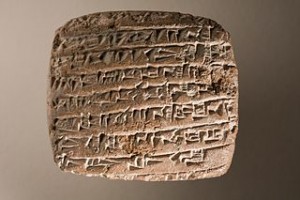“Today, we recall our lists from a computer terminal, not from the memory of a bard.” (from the video Homer and the Oral Traditions [*])
A list – a stream of unconnected data – is a challenge for the unassisted human memory. The H-LAM/T has a number of tools for storing and retrieving lists.
Ong [*] provides examples from oral texts of lists, such as Homer’s catalog of ships, and the lists of ‘begats’ in the Torah, which are “in a total context of human action: the names of persons and places occur as involved in doings.” These arise from the oral culture’s use of formulaic structures and the oral drive towards redundancy, both of which are aids to memory.
 The earliest examples of writing, cuneiform tablets, were used for making lists and keeping records.
The earliest examples of writing, cuneiform tablets, were used for making lists and keeping records.
Lists are also among the earliest uses of computer hypertext systems. In his remarkable demonstration of the augmentation of human intellect by the computer, Douglas Engelbart chose to use a shopping list as his first illustrative example.